
About
Tucked away in Captain Cook, twelve miles south of Kailua-Kona, Amy B.H. Greenwell’s garden legacy preserves her devotion to Hawaiian botany, archeology, and culture.
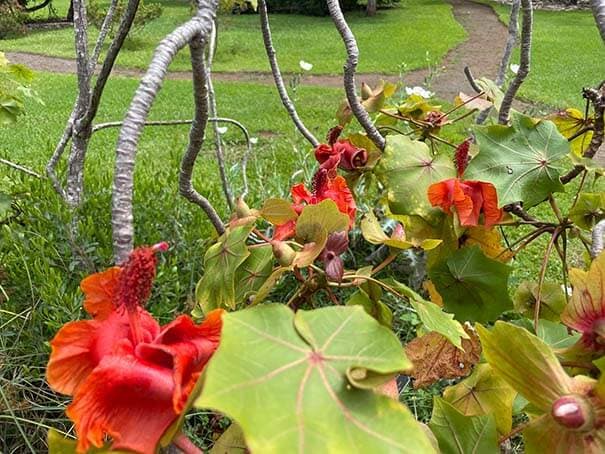
Over 200 native plant species
About The Garden
Amy Greenwell Ethnobotanical Garden is a vibrant 15-acre biocultural kīpuka – a protected remnant of land with plants and agricultural features from an earlier era. Located in South Kona, the Garden, which is also an officially designated community forest, showcases over 200 species of native and Polynesian-introduced plants that predate the arrival of Captain Cook in 1778. From culturally significant plants like kalo (taro) and maiʻa (banana) to rare and endangered species like kōki’o (Kokia species), this garden is a treasure trove of Hawaii's botanical heritage. The Garden also includes a fascinating 5-acre archaeological site, preserving the features of ancient Hawaiian agricultural lands that once fed a large population in Kona.
As you wander through the Garden, you'll experience a variety of ecological zones, from coastal and dry forests to lush agricultural and wet forest areas. It's not just a place of beauty—it's a living classroom dedicated to conserving native plants and supporting traditional Hawaiian land use and cultural practices.
Our History
Kona Field System Established
Establishment of the Kona Field System by Native Hawaiians, featuring large stone archaeological features around which a thriving upland agricultural system developed to feed a population comparable to that living on the Big Island today.
Bishop Museum
The Garden bequeathed by Amy Greenwell to Bishop Museum for the purpose of conserving an example of the historic Kona Field System and curating a collection of native (endemic and indigenous) and Polynesian-introduced “canoe” plants used for food, fuel, fiber and medicines.
Public Opening
After a number of archeological studies and several years of planting and curating a unique collection of native, rare, endangered and useful Hawaiian plants, Amy Greenwell Ethnobotanical Garden opened to the public, becoming a beloved landmark for knowledge sharing, cultural activities and nature appreciation.
Community Ownership
After more than 30 years as part of Bishop Museum, the Garden devolved to community ownership, marking a new chapter in a rich history starting with several phases of agricultural production and now transitioning to a new existence as an anchor of biocultural knowledge sharing and a source of enjoyment for local residents, students and visitors for years to come.




A History of Stewardship
Managed by a non-profit community organization, the Garden plays a dual role as a popular tourist spot and an educational hub. With over 11,000 visitors each year, including more than 1,500 schoolchildren, it offers interactive tours and workshops on Hawaiian culture, agriculture, and traditional arts like kapa making and wood carving. These hands-on experiences connect visitors of all ages to Hawaii's rich cultural traditions and sustainable agricultural practices.
By nurturing a living collection of native plants and offering educational programs, Amy Greenwell Ethnobotanical Garden ensures that the agricultural wisdom and botanical resources of ancient Hawaii continue to thrive in the modern world. It's a place where history, culture, and nature come together to inspire and educate, ensuring these vital traditions are passed on to future generations.
A life building to the garden
About Amy Greenwell
Amy Beatrice Holdsworth Greenwell, born in 1920, was deeply connected to the rich history and culture of Kona, Hawaii. As the daughter of Arthur Leonard Greenwell and Beatrice Hunt Holdsworth, she was one of 23 grandchildren of Henry Nicholas Greenwell, a pioneering merchant and rancher who arrived in Hawaii in the 1850s. Among Henry's many land acquisitions, the purchase of the ahupua’a (a Hawaiian land unit) of Kealakekua in 1881 was the largest. This land was inherited by his second son, Arthur, Amy’s father.
Amy Greenwell was a talented individual with a genuine passion for plants and archaeology. She attended Stanford University, joined Gamma Phi Beta, and served as a nurse during World War II. After the war, she collaborated closely with renowned botanist Dr. Otto Degener at the New York Botanical Garden and later at Bishop Museum in Honolulu, contributing significantly to Book 5 of Flora Hawaiiensis, a key reference on Hawaiian plants. Dr. Degener praised her work in the 1957 introduction to the volume, noting her efficient collaboration and active co- authorship. Her work at the botanical garden was cut short when she returned to Kona in the mid-1950s to build a small home in Captain Cook and focus on her botanical and archaeological interests.
Back in Kona, Amy began to transform her property by planting native and Polynesian- introduced species in the region's historic agricultural fields. Her dedication to preserving Hawaii’s natural and cultural heritage extended to her archaeological studies of early Hawaiian sites, such as Ka Lae (South Point). Her commitment to these causes led her to bequeath her property to the Bishop Museum upon her death in 1974. Amy Greenwell Ethnobotanical Garden, established in her honor, stands as a testament to her legacy, promoting the conservation of native plants and educating future generations about Hawaii’s unique cultural and botanical heritage.
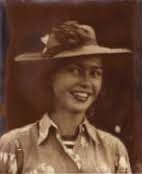

Stay up to date with events and news from the garden!
Sign up for our newsletter.


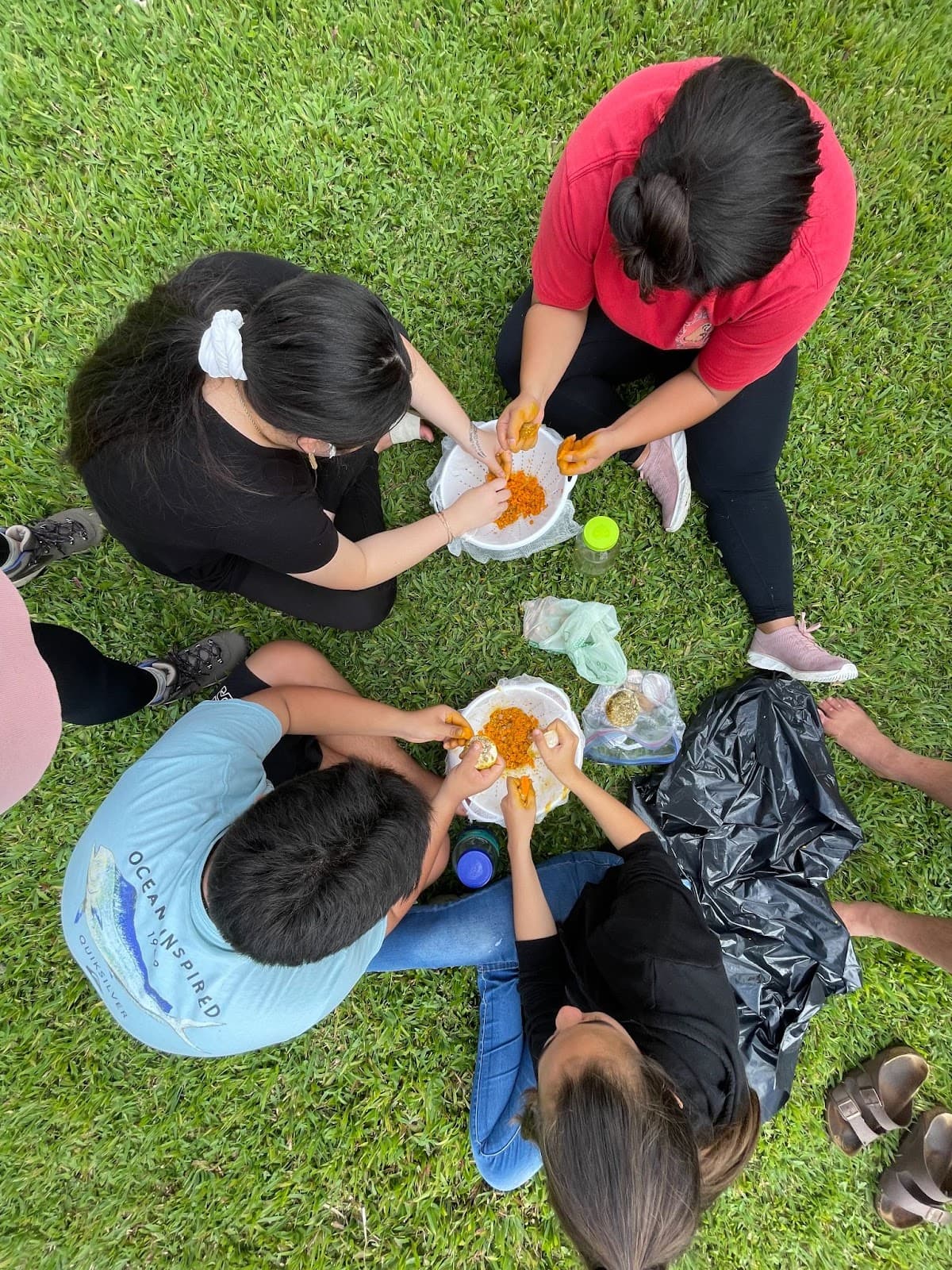
What is ethnobotany?
Ethnobotany
Ethnobotany is the scientific study of the relationships between people and plants, focusing on how different cultures use and perceive plant life. It explores traditional knowledge about plants, including their uses in medicine, food, and rituals, and examines how this knowledge has been passed down through generations. Ethnobotanists investigate the ways in which plants contribute to cultural practices and societal functions, from agricultural techniques to crafting materials. By documenting and analyzing these relationships, ethnobotany helps preserve cultural heritage and provides valuable insights into sustainable practices and the conservation of plant species.
In addition to its cultural significance, ethnobotany contributes to modern science by offering a rich source of information for discovering new plant-based products and applications. For example, in Hawaii, traditional practices involving native plants such as wauke (Broussonetia papyrifera) and kalo (taro) illustrate key areas of ethnobotanical research. Wauke, used to make kapa (bark cloth), plays a vital role in Hawaiian cultural practices, showcasing the sophisticated techniques of traditional fiber arts. Kalo, a staple food crop, has deep cultural roots and significant agricultural value. Researchers also explore the traditional uses of plants like ʻawa (kava) in social and ritual contexts. By documenting these practices and their underlying knowledge, ethnobotany helps to preserve Hawaiian cultural heritage and provides insights into sustainable agriculture and conservation strategies.
Native Plants Conservation
Hawai‘i is one of the most geographically isolated places on the planet, being over 2,000 miles from a continental landmass and nearly 1,000 miles from even the tiniest of islands. It was therefore very difficult for the original plant and animals inhabitants to colonize the islands and few actually made it. Before Hawaiians arrived in the islands the only animals present were birds, insects, a couple small reptiles, and one mammal – the hoary bat. The birds brought with them most of the flowering plants and the rest were carried over by the wind along with the spores of ferns and fungi. Scientists estimate that a new species arrived in Hawai‘i once every 20,000 to 50,000 years.
Successful plant immigrants found the islands a fertile land to occupy, with a moderate climate and an abundant rainfall. There were no grazing animals and few insects or pests in addition to minimal competition for sunlight and nutrients. These colonizing species rapidly spread out over their new home.
As these plants spread out across the islands they began to change, slowly forming new species. Several influences facilitated these changes. First of all their new habitat was very different from their old ones. The absence of grazing animals, for instance, caused many plant species to become more docile by losing their thorns and toxins. The absence of bees to pollinate some plants caused the plants to change in order to attract other animals such as birds or fruit flies.
There was also the ecological variability of Hawai‘i, which contains virtually every ecological zone on the planet. Therefore a plant could land and inhabit a dry plains area, and as it spread out it found itself within a rainforest and had to adapt accordingly. There was also the genetic isolation of species. If only a few individuals accomplished the journey to Hawai‘i the genetic pool is very small and inbreeding is inevitable. In addition there was further isolation within the chain, such as the isolation between islands or even the isolation between the steep mountain ridges separating the valleys.
Due to these factors the original species the arrived in Hawai‘i became completely new and unique species. These species are known as endemic, meaning they are found here and no where else in the world. Hawai‘i has the highest rate of endemism in the world, over 90%. While this means our species are original, it also means they are vulnerable because if they disappear from Hawai’i, they are extinct. Although Hawai‘i constitutes less than 1% of the United States land mass, it posts the most threatened, endangered, and extinct species.
Many of these plants species are conserved and displayed here at the garden. These species are propagated both for conservation projects that reintroduce them into the wild and also for private consumption. That’s right, you can buy endangered Hawaiian plants at our garden for your private landscaping desires.



Kona Field System
Amy B.H. Greenwell Ethnobotanical Garden is located within the ahupua’a, or traditional land division encompassing costal and mountain resources, of Kealakekua. Kealakekua, which mean “the path of the gods,” is a culturally and historically significant area.
Near the shoreline one would find coconut trees and small patches of ‘uala, or sweet potato, intermittedly dispersed among the various cooking, storage, and living facilities. It was here near the seashore where majority of the craft work was done such as beating bark cloth, weaving, and carving as well ocean activities such as fishing and gathering seaweed and other marine resources.
As we head mauka, or towards the mountain, from the coast we cross the lowland dry plains, known as kula lands. These lands still suffer from salt spray and very arid conditions, allowing few useful plants to grow in this zone. Typically wauke, or paper mulberry, from which Hawaiians made their bark cloth, was grown in this area, which persisted until about 500 feet elevation.
Above these wauke plantations began the ‘ulu, or breadfruit, groves for which the traditional zone, kalu’ulu, derives its name. These large trees provided considerable amount of food and also provided shade and captured moisture to house other sub-canopy crops. The ‘ulu groves typically extended to about 1,000 feet elevation, at which point the rain line would allow for more intensive agriculture.
The major agricultural zone, known as ‘āpa‘a, began with the rain at about 1,000 feet and extended up to about 3,000 feet. This is the zone in which Amy B.H. Greenwell Ethnobotanical Garden is located as well as the archeological remains known as the Kona Field System.
While majority of the Hawaiian agricultural systems utilized terraces, the Kona Field Systems, possibly because this area is relatively so dry when compared to the rest of the state, developed an original system consisting of long rock walls, known as kua’iwi, that ran parallel to the slope of the mountain. In between these divisions was heavily planted with the major food crops of kalo, or taro, and ‘uala, using techniques such as mounding and mulching to conserve the scarce water as much as possible. Along the walls, which doubled as paths through the plantations, were planted other significant crops, namely kō, or sugar cane, and kī, or ti leaf. Along the upper boundary of this zone we would find less significant crops such as mai’a, or banana, and uhi, or yams.
Mauka of the ‘āpa‘a zone began the wao akua, or realm of the gods. This was the dense forest that was unaltered by the Hawaiians. Several resources were collected from this area including the Hawaiian honeycreepers, collected for their feathers, and koa (Acacia koa), which was felled as lumber for canoes.

Our team
"He waʻa he moku, he moku he waʻa." "Our canoe is an island, our island is a canoe."
This ʻōlelo noeau compares an island to a canoe, in that we must "paddle" together in order for the canoe to reach its destination. In the same way, we must work together (and depend on one another) on these island communities to ensure we can succeed and sustain ourselves in the future! Our waʻa cannot continue to sail without our amazing hui. Mahalo nui to our staff for the amazing work you put into the Garden!

MaryAnne Maigret
Executive Director
MaryAnne comes to the Garden with broad expertise in Hawaiian history, plants and archaeology and as executive director, aims to preserve the cultural landscape of the garden so that the world can understand the immense significance of the Kona Field System, its landscape, plants, and the people attached to it. She comes to the garden from 24 years of public service as an archeologist and historic preservation specialist, most recently as the Integrated Resources Manager at Pu'uhonua o Honaunau National Historical Park, and previously as the Hawaii Island Archeologist for the Hawai'i Division of State Parks and its State Historic Preservation Division. In the years between graduate school and public service, she was an archeologist and field mapping specialist, a professional cartographer, university lecturer, and an ethnobotanical intern at the Amy Greenwell Garden. She holds degrees in Geography from the University of California Berkeley and a Masters degree from UH Manoa, which set a solid foundation for her future work. She has hands-on working knowledge of the Kona Field System through professional archaeological work, and her family farm in Honaunau with its intact Hawaiian field system landscape. She is very happy to be returning to the garden in her new role and to join with the community to malama this special place.
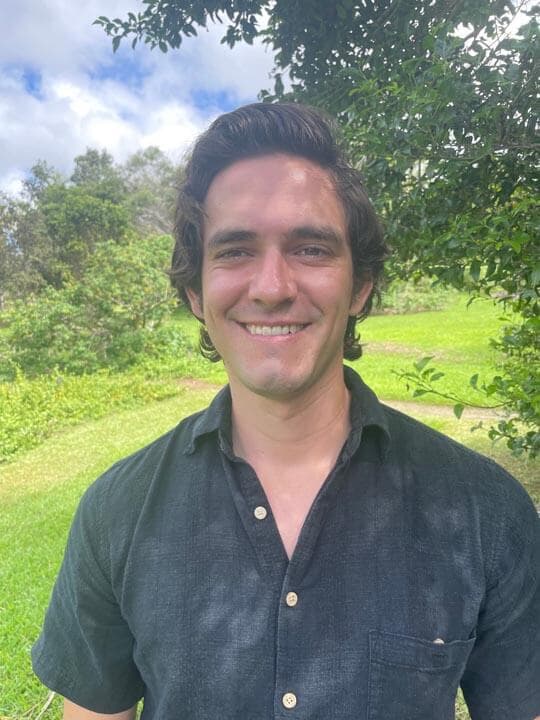
JOSEPH PRYZDIA
Garden Manager
As the garden manager at Amy Greenwell Ethnobotanical Garden, Joe Pryzdia works to enhance the botanical collection, conserve native Hawaiian plant species, and preserve indigenous crop diversity. He aims to create a community space where ethnobotanical and cultural knowledge can be shared. Joe developed a deep appreciation for the flora and ecology of Hawaiʻi while earning his M.S. in Botany at the University of Hawaiʻi at Mānoa. Through his time spent exploring Hawaiʻi’s unique plant communities, he became keenly aware of the many threats to native flora and the pressing need for conservation efforts. Before relocating to Hawaiʻi, Joe earned a B.S. in Environmental Science from Lewis University in the greater Chicago area, where he gained experience in restoring wetlands and tallgrass prairies, along with horticultural practices, during an internship at The Morton Arboretum.

SYLVIA TEXEIRA
Education Coordinator
Sylvia Texeira is a passionate educator and nature enthusiast who is thrilled to join the team at Amy Greenwell Ethnobotanical Garden. She brings her deep-rooted love for science and culture into this enchanting botanical setting. Her journey as a lifelong student of the natural world has been shaped by the stunning landscapes of Hawaii. From an early age, she was drawn to environmental education, blending science and culture to reflect the rich tapestry of the island. Over the years, Sylvia has focused on creating immersive learning experiences that combine hands-on exploration, cultural immersion, and project-based education. Her tenure at West Hawaii Explorations Academy allowed her to develop curricula that seamlessly merge environmental science with cultural insights. Now, as she embarks on this new chapter at Amy Greenwell Ethnobotanical Garden, she eagerly anticipates merging science, culture, and conservation in the spirit of aloha, hoping to inspire the next generation of stewards of Hawaiʻi’s natural heritage.

EMILY EBERT
Administration & Finance Manager
Emily Ebert grew up in central Ohio, attending Mount Vernon Nazarene University where she received a bachelor’s degree in accounting. After college, an opportunity to work for an international electronic trading firm led her to Chicago where she gained experience in tracking and reporting financial trade data for the firm. After 5 years in Chicago, the yearning for year- round warm weather and a slower pace of life brought her to Hawaiʻi Island. Beginning her career on the island, Emily worked in the construction industry, managing the office of a general contractor. Enjoying the contracting industry, she continued her career in renewable energy at a local solar electric contractor for over a decade. It was very rewarding to help people harness the energy from the sun and reduce electricity costs. After exiting the solar electric industry and wanting to try something new, she started a cottage bakery selling baked goods at a weekly market but missed working with numbers and keeping data organized. She was excited when the opportunity came up to join the Amy Greenwell Ethnobotanical Garden staff as a bookkeeper. Emily has loved her time at the Garden and looks forward to learning more about native plants while helping continue the Garden’s mission.
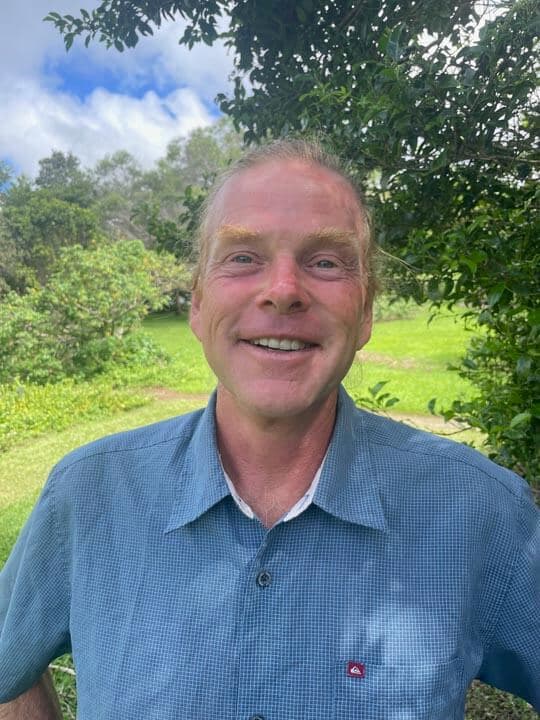
BILL CULLUM
Horticulturist
Bill Cullum grew up in North Carolina in the Blue Ridge Mountains, at the foot of the Appalachians. Surrounded by forests and farming, he developed a fascination with plants and sustainable gardening. He attended Clemson University in the Upstate of South Carolina, also nestled against the Blue Ridge Mountains, where he earned a degree in horticulture. After working in the nursery and greenhouse industry there, he eventually decided to relocate to Hawaii. He settled in South Kona, where he worked in landscaping and farm maintenance. As he learned more about Hawaiian culture and the native plants that support it, he began volunteering at the Amy Greenwell Ethnobotanical Garden, eventually becoming an employee. There, he led workshops and collaborated with community members to promote biodiversity and sustainable agriculture. His dedication to preserving Hawaii’s unique ecosystems is evident in his work, where he combines traditional practices with modern science. His passion for plants not only enriches the landscape but also fosters a deeper appreciation for nature among residents and visitors alike.
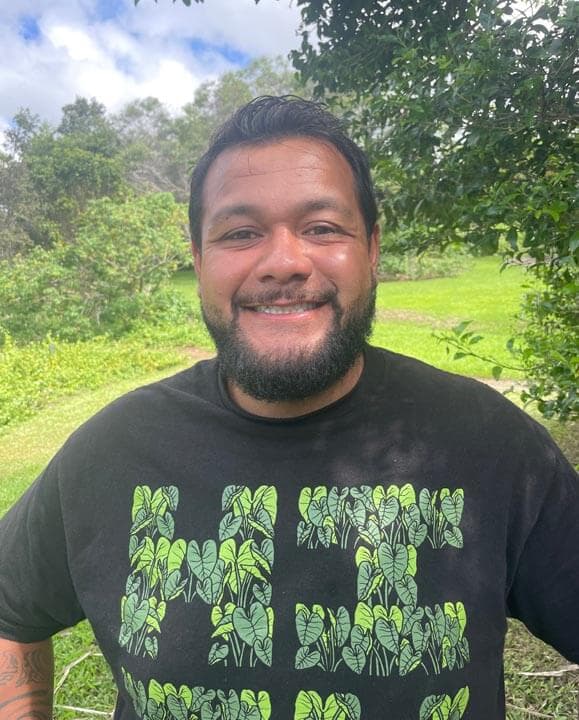
SAMUEL MAHELONA
Community Forest Maintenance Worker
Samuel Mahelona was raised on Moku o Keawe. After graduating from Konawaena High School in Kealakekua in 2013, he pursued studies in mechanized agriculture at Fresno State University, where he was introduced to forestry and fire science. During his time there, he worked with Cal- Fire and other first responders to mitigate fire fuel risks and remove hazardous trees from right- of-ways. After relocating from California to Tennessee, he contributed to tornado restoration work and emergency responses to hurricane damage. A skilled heavy equipment operator and contract sawyer, Samuel also provided consultation on vegetation management near or on power distribution facilities. He has now returned to the Big Island to share his expertise with the Lahui.
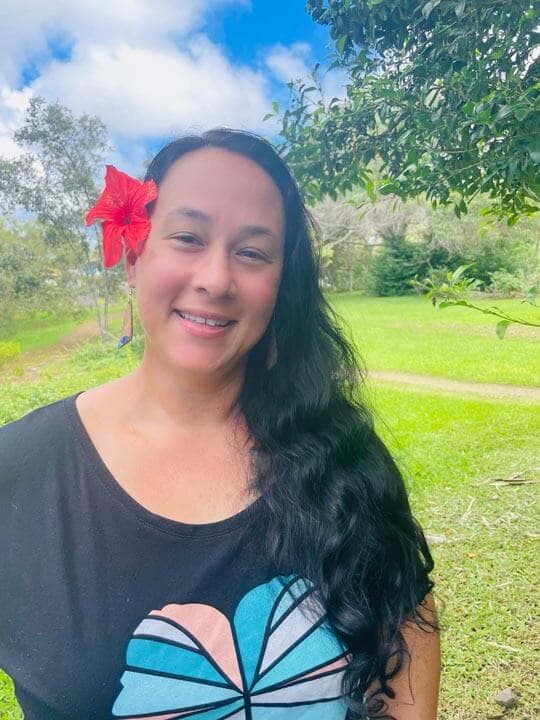
ALOHA REEVES
Volunteer Caretaker
Aloha Reeves was born and raised in the ahupua’a of Kealakekua, (specifically in the village of Napoʻopoʻo), and was employed at Amy Greenwell Ethnobotanical Gardens in 2010 as a volunteer then as a Hoʻokipa Ambassador, until the Garden’s closure in 2016. She is now an informal volunteer caretaker here at the Garden. Aloha was a youth advisor for the Tree Reforestation Program, Hawaiʻi AIDS Foundation, and Konawaena High School. She received awards from Hui Laulima, American Red Cross, Hawai‘i county and state, and from the community for her local contribution. In her spare time, Aloha enjoys spending time with her four children, ‘ohana and friends, as well as researching Hawaiian genealogy. Her lineal ancestors include many contributors to Kona and the island: her kūpuna who cared for the island’s ahupua'a systems; a guide for vulcanologists on Mauna Loa and Kīlauea; the first Kona coffee farmers; a director of the State Department of Land and Natural Resources. From these kūpuna Aloha developed a passion of love for the land of Hawai'i and all its people and wants to continue to contribute to her community and the children of Hawaiʻi.

PETER VAN DYKE
Volunteer, Adviser, Garden Manager Emeritus
Peter worked at Amy Greenwell Garden from 1990 to 2023, starting in the nursery and then as garden manager. When he started, the garden staff had just finished clearing the exotic trees and shrubs and had planted grass ground cover, so the garden was for the most part a blank slate. He saw the construction of the nursery, workrooms and the visitor center, the layout of trails and the planting of beds throughout the garden. He worked on signs, brochures, benches and amenities. He helped develop school programs, self-guided visits, workshops, and festivals. Since retiring he has become a regular Saturday morning volunteer at the Garden, tends his own farm in Honaunau, and gets into the ocean at every opportunity. On a regular basis, he acts as informal adviser on all things Garden-related, from how to germinate plants and prevent weeds to where to find a trowel or design an interpretive exhibit.
Introducing
The Friends of Amy Greenwell Garden
The Friends of Amy B. H. Greenwell Ethnobotanical Garden is a 501(c)3 non-profit organization with the mission of protecting and invigorating the Amy B. H. Greenwell Ethnobotanical Garden created for the purposes of:
- Raising funds to help support the purposes and goals of the Garden.
- Working with government officials, NGOʻs and other interested parties to ensure and enhance the Garden's future.
- Fostering public understanding, enjoyment, and conservation of the natural and cultural resources of the Amy B. H. Greenwell Ethnobotanical Garden and our community forest.
- Providing volunteers for important Garden projects.
Board of Directors
- Noa Kekuewa Lincoln - President (2025) Noa is a Native Hawaiian born in Kealakekua. He is the former Ethnobotanical Educator of the Amy B.H. Greenwell Ethnobotanical Garden. He has worked extensively in plant conservation, ecosystem management, and indigenous food issues in Hawai‘i and around the Pacific Rim, as well as Brazil and the American Southwest. Much of his current research examines the traditional Hawaiian rain-fed agricultural systems, and how traditional agricultural practices affect nutrient cycling and productivity. He is the lead scientist for several Hawaiian agricultural sites, such as Ulu Mau Puanui and Māla Kalu‘ulu. He has a BS from Yale University in Environmental Engineering, and a PhD from Stanford University in Interdisciplinary Resource Management. He is currently Assistant Professor of Indigenous Crops and Cropping Systems with the University of Hawai‘i, Hilo. He is the author of numerous articles, and also a Guidebook to Native Hawaiian Plants at the Garden, published by B.P. Bishop Museum. He has done extensive work on indigenous Hawaiian sugarcane varieties, many of which are at the Garden. Kō, An Ethnobotanical Guide to Hawaiian Sugarcane Cultivars, was published in 2020 by UH Press.
- Rose Schilt - Vice President (2026) As a community advocate, Rose felt called to return to the Garden when it was in jeopardy in 2016, and joined in the founding of the Friends to ensure its future. She served as the second manager of the Garden in the 1980s, as it was being planted and prepared for public opening. With Master’s degrees (University of Hawai‘i; Illinois State University) in archaeology and public health, she has worked in Hawai‘i, the Pacific, and the US Midwest, directing archaeological and public projects. She brings twelve years of experience as a nonprofit executive director and Weinberg Fellow, focusing on youth, families and community health. It is critical now that the Garden thrive as a cultural and educational center for a sustainable future. Rose is grateful to be part of the passionate, diverse circle coming together to Hānau Hou, revitalize the Garden!
- Alan Rolph (2026) Alan is ecstatic about his return to the Big Island. He was born in Honolulu, moved to New Zealand and returned to the Big Island to attend High School at Hawai‘i Preparatory Academy. He graduated from Denison University and the University of Cincinnati with a Master’s degree in Geology. His career with Shell Oil took him worldwide in search of energy resources. Now retired, he enjoys woodworking and making improvements to a 5-acre property and home in Captain Cook. Alan has always had great love for nature and history. He is a descendent of the Cooke family who arrived with the 8th company of missionaries to Hawai’i in 1837. The Amy Greenwell Garden holds a very special place in his heart as his mother, Dorothea Rolph, worked with the Garden in its early years helping to propagate and grow native Hawaiian plants. He is looking forward to continuing this work of maintaining and preserving this region’s native plants and their cultural history entwined with the people of the Big Island.
- Nathan Smith (2025) Formerly a resident of Kealakekua, Nathan recently moved to North Carolina, but continues his commitment to the Garden. He believes that “The Amy B.H. Greenwell Ethnobotanical Garden is a unique and irreplaceable gift — from Amy, from many years of stewardship by the Bishop Museum, and from years of care by Garden Staff and Volunteers. The time has come for our community and island to preserve this gift and bring it to its full potential." He has been a commercial real estate and energy attorney in Portland, Maine for 35 years. As an attorney he has received many peer recognitions including being listed in Best Lawyers in America for the past 15 years. Nathan has worked on numerous land conservation transactions and was the first person in Maine to receive the National Park Service’s ‘Conservation Hero’ Award in 1993. He has been a community leader for decades, which has included holding leadership positions in a broad spectrum of community organizations as well as serving on the Portland City Council for two terms and as Portland’s Mayor in 2003-4.
- Angelica Ku’ulei-Fowler Stevens (2027) Angelica was born in Kealakekua, attended Holualoa Elementary and Konawaena High School, graduating in 1988. After leaving home for California and Germany for 10 years, she returned to Kona, her “best place in the world.” She received her BA and MA degrees in Political Science and China-US Relations at UH-Hilo. After graduation in 2010, Angelica turned her attention to revitalizing her family’s 9-acre Kamehameha Schools farm-lot. Employing methods of agroforestry, many of the Hawaiian trees that she now grows her crops under come from Amy Greenwell Ethnobotanical Garden. Angelica has sought the advice of the Garden’s staff for many years, and in 2014 the farm received recognition from the USDA/Kona Soil and Water Conservation District as “Agroforester of the Year.” Angelica was also instrumental in reforestation at the West Hawai’i Veterans’ Cemetery, writing grants and assisting with planting projects. Angelica is devoted to the restoration of native Hawaiian plants on our local farms and public landscapes. She is thankful to play a role in helping that happen, both from her farm and with Amy Greenwell Ethnobotanical Garden.
- Kanani Wall (2026) Kanani was born in Kona, attended Konawaena High, and grew up playing under the bleachers at Greenwell Park. She spent much of her childhood on her Grandpa’s coffee, macadamia nut, vegetable, and anthurium farm, where she learned mālama ‘āina. Her father ran a glass- bottom boat in Kailua Bay, where she grew a deep love and respect for the ocean and its biodiversity. Kanani and her husband have 6 children between the ages of 17 and 31, and they are the sixth generation paniolo on Wall Ranch. Kanani is Director of the Alternative Learning Opportunity Program, Department of Education at Konawaena High School. She received a BA in Education from the University of the Pacific and a Master of Education from UH Mānoa in Curriculum Studies. She has worked as an elementary school teacher and as school administrative staff, as well as in community education. She has spent time in the Garden as an educator with groups that she brought, as well as a volunteer with an afterschool group known as Hua o Ke Ao.
- Ben Kauhane Heloca (2027) Ben is a Hawaiian Cultural Practitioner, including for kapa making, lauhala weaving, woodworking, and horticulture of native plants at the Garden. He is retired from the State of Hawaiʻi Judiciary, Kona. Ben is as a Hawaiian language instructor for “Hāleo” at the U of N and also at “Kupuleo” at the King Kamehameha at Kona Beach Resort. He also serves as a board member for ʻAhuʻena Inc, Hui ʻo Hanohano, Hawaiʻi Kuauli and Aha pule.
- Patricia "Pat" Todd - Vice President (2026) Pat has been on the Board since 2017 and is immensely proud of having been able to participate in the purchase of the Garden in 2019 and serve during this period of renewal and transformation. She looks forward to working with the staff and the Board to ensure that the Garden continues to play an increasingly critical role in conserving and revitalizing the natural and cultural life of the region. Pat has over 20 years of corporate experience in Human Resources and volunteered on many nonprofit boards during that time. After spending eight years as a dedicated volunteer at Denver Botanic Gardens, it was an easy transition from a high-plains steppe garden in the Rockies to Amy Greenwell Ethnobotanical Garden in tropical Captain Cook. Pat and her husband, Jim, who is also an active Garden volunteer, live on a 6-acre farm where they grow coffee, cacao, citrus as well as many native plants and trees.
- Marie Morin - Secretary (2025) As a conservation biologist, Marie has a Ph.D. from the University of Hawai‘i, and has worked with native and endangered species throughout her career with various agencies and educational institutions. Since 1980 she has resided and worked on O‘ahu, Oregon, Kaua‘i, and Hawai‘i Island. Marie’s support of the Garden stems from her long-time interests in Hawaiian culture, the perpetuation of endemic plants and animals, and sustainability through locally- sourced food and energy. One of her favorite quotes: “Grow where you are planted.”
- Steve Valdez - Treasurer (2027) Steve retired to the Kealakekua area of the Island in 2021 with wife Jennifer and from (almost) day one, has been volunteering at “The Garden”. The knowledge gained from interacting with the staff and other volunteers has been invaluable in learning about the rich history and spiritual connection of the plants, land and people of Hawai‘i. Additionally, the practicality of where, when and how to plant has its own never-ending story that is vital to the success of any island gardener or farmer. Steve completed a 32-year career with civilian law enforcement as a forensic scientist. He worked with several crime laboratories in Arizona and his duties ranged from an entry level lab technician to finishing his career as a supervisor over several forensic disciplines. During this time Steve also served as president, chairman of the board, board member and treasurer of the professional organization Southwestern Association of Forensic Scientists. Steve currently serves as a committee member and treasurer of historic Christ Church Episcopal in Kealakekua. Steve earned his Bachelor’s degree in Chemistry from the University of Arizona.
- M.E. "Meg" Greenwell (2027) Meg is a niece of Amy B. H. Greenwell and remembers visiting her at her residence and garden property. She is President of the family corporation, Kealakekua Ranch, Ltd., of which Amy was a Director and Treasurer for many years before her death. Kealakekua Ranch/ChoiceMart received the competitive 2016 Statewide Family-owned Business of the Year Award through the Small Business Administration. Through her personal enthusiasm and recognized leadership, Meg carries forward a generations-long concern for serving Kona through family business, promoting local jobs and local foods, and also advancing charitable interests and community events. Kealakekua Ranch, Ltd. donated the land on which the Visitor Center is located and is very interested in the Garden and committed to seeing it service the community again.
- James Hershey (2025) James was born in Kansas, but he has lived in the Islands since the 1980s. He graduated from Sonoma State Univ. (CA) with majors in Biology and Environmental Studies & Planning and obtained his law degree from Hastings College of Law in 1981. He is a Founding Partner of a law firm in Hawai‘i and was a Judge in the First Circuit (Honolulu) until his retirement in 2016. Some of his professional specialties were mediation and arbitration, as well as real estate and product liability. He and his wife (Patricia Kehau Wall) are now coffee farmers on the lot just above Amy Greenwell Garden and they enjoy travel, golf, and family.
- Shirley A. P. (Cho) Kauhaihao (2025) Shirley has volunteered at the Amy B. H. Greenwell Ethnobotanical Garden for 15 years. She was the lead organizer for the cleanup of coral graffiti along Queen Ka’ahumanu Highway – this cleanup was completed in approximately three years of Sundays. She is a Master Weaver, member, and past president of Ka Ulu Lauhala ‘o Kona, the annual weaving conference, and has participated in events in Hawai‘i and Washington, D.C. She is also a chef of Hawaiian cuisine, assisting top chefs in our state and sharing knowledge in many Pacific islands. Shirley’s family ties and commitment to the Garden go back decades.
- Brien Meilleur (2027) Brien, now retired, is an ethnobiologist currently Associate Researcher at the Laboratoire d’Éco- anthropologie at the French National Museum in Paris. He received his PhD degree in 1985 in Socio-cultural Anthropology from the Department of Anthropology at the University of Washington in Seattle. He has held positions as Manager of the Amy B.H. Greenwell Ethnobotanical Garden from 1987 to 1994 and then as President and Executive Director of the Center for Plant Conservation from 1994 to 2001. He has worked as a consultant for the International Plant Genetic Resources Institute (IPGRI now Bioversity International), for the Food and Agricultural Organization (FAO) of the United Nations, and for the European Union. With the assistance of garden staff and private individuals throughout Hawai‘i, while Manager of the Amy Greenwell Garden, then a unit of the Bishop Museum, he assembled several of the foremost living collections of traditional Hawaiian cultivated plants (cultivars), some of which still exist at the garden today. He has received over 15 research grants and is the author of 60 scientific publications including six books (three in French). Brien is a Vietnam veteran and while serving in the US Navy he participated in the recovery of the Apollo XVI astronauts. With his wife Sylvie he spends his time between Seattle and Savoie, France.
*Note: Year shows end of an elected 3-year term, in Fall of that year at our Annual Meeting. No term limits. This list is current as of October, 2024. New Members will join after our Annual Meeting in early November, 2024.
Mahalo to Our Funders
...and to our legacy funders
Cooke Foundation, Ltd.
Atherton Family Foundation
Contact Us
Garden Hours
- Monday:Closed
- Tuesday-Saturday:9am - 4pm
- Sunday:9am - 2pm
Holiday Hours
- Thanksgiving Day:Closed
- Christmas Day:Closed
- New Years Day:Closed
Contact Us
- Phone number
- +1 (808) 767-1814
Garden Location
Amy B.H. Greenwell Ethnobotanical Garden
82-6160 Hawaii Belt Rd
Captain Cook, HI 96704
USA